Garden Designers Roundtable: Gardening with Deer in Central Texas
If only all deer were as welcome in our gardens as Santa’s…
But they’re not—at least not for most of us who want an attractive, diversely planted landscape around our home. Despite Bambi’s cuteness in the wild, in the garden deer are chomping and antler-rubbing pests that will shred your shrubs, scar the bark of young trees, and reduce your favorite annuals and perennials to masticated stubs. Can you tell I’m not a fan? I know, I know—some tender-hearted folks will insist that deer were here first and we’ve destroyed their habitat, so it’s only right that we now welcome them to the buffet table of our gardens. But there are more deer here now than in pre-Colonial times. Why? Our suburban yards make ideal deer habitat, and we’ve eliminated the predators that once kept their populations in check (see this Spring 2007 article in Wildflower Magazine).
So what can you do if deer frequent your yard and you want a beautiful garden or even just some attractive foundation beds? Let’s face facts—you can eat only so much venison. Alternatively, you can build a tall fence…
…or you can be crafty and plant the kinds of plants deer find distasteful. Happily, Central Texas gardeners have lots of choices for plants deer don’t enjoy. This doesn’t mean they won’t eat them when times are tough (as in our current drought) or if your area has a serious overpopulation of deer. But at least these plants won’t be first on the menu. I’ve categorized a short list of my favorites below. An asterisk indicates plants that are native to Central Texas.
Fragrant/smelly leaves
Mexican oregano (Poliomintha longiflora), one of my favorite plants for sun, has minty leaves and tubular, lavender flowers throughout spring and summer. It’ll also grow in part sun, though it won’t get as full or flower quite as much.
‘Senorita Rosalita’ cleome, a bushy annual introduced by Proven Winners that blooms from spring to frost. I don’t find it to be as stinky as other cleomes, but the deer in my garden have never touched it.
Silver, fragrant-leaved ‘Powis Castle’ artemisia, with equally deer-resistant ‘Sapphire Skies’ Yucca rostrata, a great combo.
Lantana (Lantana urticoides)*, a tough, summer-to-fall blooming, woody perennial that needs no babying to look great.
Garlic chives (Allium tuberosum), the only allium that performs in our hot, dry climate. Watch out for vigorous re-seeding!
Autumn sage (Salvia greggii)*, a gorgeous, woody perennial that blooms in spring and fall. Just give it lots of sun and at least three hard trimmings a year to keep it looking good. Brush its leaves with your fingers to revel in its minty clean scent.
Grassy
Bamboo muhly (Muhlenbergia dumosa), a New Mexican clumping grass with gorgeous, chartreuse leaves that slightly resemble bamboo.
Mexican feathergrass (Nassella tenuissima)*, a spring-blooming blond beauty. Watch for re-seeding with this one too.
Inland sea oats (Chasmanthium latifolium)*, a shade or morning-sun grass with pretty seedheads that are apple-green in summer and toasty brown in fall. Again, a vigorous re-seeder.
Gulf muhly (Muhlenbergia capillaris)*, which frothily blooms cotton-candy pink in fall before fading to tan in winter.
‘Sparkler’ sedge (Carex phyllocephala ‘Sparkler’), a low-growing, green-and-cream evergreen for shade. It likes a little more water than most of the plants on this list.
Fibrous
Wheeler’s sotol (Dasylirion wheeleri), a spiky, blue sphere for sun that requires very little water. Equally good is our native green sotol (Dasylirion texanum)*, which can take sun or part shade.
Well-named, evergreen cast-iron plant (Aspidistra elatior), great for dry shade. In our hot climate, there are few broad-leaved plants that don’t require lots of water, so take advantage of this one.
Softleaf yucca (Yucca recurvifolia)*, with deer-resistant Chinese fringeflower (Loropetalum chinense var. rubrum), one of the few burgundy-leaved shrubs for our climate.
Note: Bucks will happily shred some yuccas and even agaves with their antlers in the fall. The texture and stiffness of the plant must be just right for rubbing off that itchy velvet. I’ve taken to spraying my yuccas with deer repellant in the fall, and that helps.
Texas dwarf palmetto (Sabal minor)*, a tropical-looking evergreen for shade or morning sun.
Fuzzy/hairy
Heartleaf skullcap (Scutellaria ovata)*, a fuzzy-and-oily-leaved native with sweet blue flower spires in spring. Deer-resistant bamboo muhly (Muhlenbergia dumosa) and burgundy cordyline (Cordyline australis ‘Red Star’), an annual foliage plant, are visible in the background.
Jerusalem sage (Phlomis fruticosa), with pretty, white-edged, fuzzy leaves and tiers of butter-yellow flowers in spring.
Lamb’s ear (Stachys byzantina), the ultimate fuzzy groundcover for dry shade.
Poisonous
Gopher plant (Euphorbia rigida). A toxic latex sap in the stems renders it unpalatable.
Jimsonweed (Datura wrightii)*, with fragrant, night-blooming flowers. All of its parts are poisonous to man and beast.
Daffodil (Narcissus), a flowering bulb that is also toxic to deer. This is ‘Ice Follies’.
So you see? You can have an interesting, diverse garden even if deer call your neighborhood home.
In fact I’m sure many of you have your own favorite deer-resistant plants. Feel free to share in the comments section!
Go ahead—plant strong-smelling, fuzzy-leaved, and grassy plants in your garden, and then you can enjoy an “Aww, sweet!” moment when you see this…in your neighbor’s yard!
This is my contribution for December’s topic at Garden Designers Roundtable. For more perspectives on “Gardening with Deer,” please visit the posts of my fellow garden designers. Happy reading!
Rebecca Sweet : Gossip in the Garden : Los Altos, CA
Lesley Hegarty & Robert Webber : Hegarty Webber Partnership : Bristol, UK
Genevieve Schmidt : North Coast Gardening : Arcata, CA
Douglas Owens-Pike : Energyscapes : Minneapolis, MN
Christina Salwitz : Personal Garden Coach : Renton, WA
Susan Morrison : Blue Planet Garden Blog : East Bay, CA
Debbie Roberts : A Garden of Possibilities : Stamford, CT
Tara Dillard : Vanishing Threshold: Garden, Life, Home : Atlanta, GA
Pam Penick : Digging : Austin, TX
Top photo courtesy of morgueFile.com
All material © 2006-2011 by Pam Penick for Digging. Unauthorized reproduction prohibited.



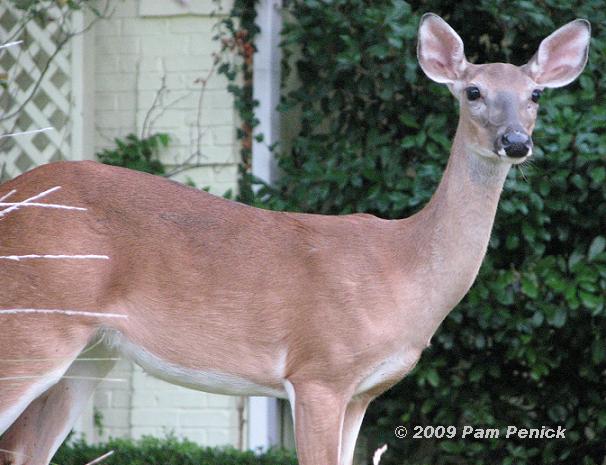
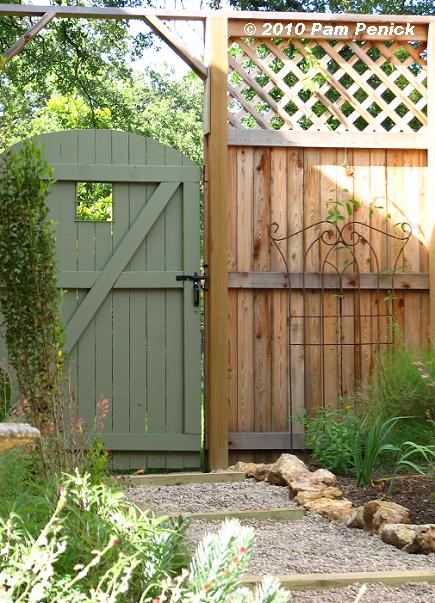
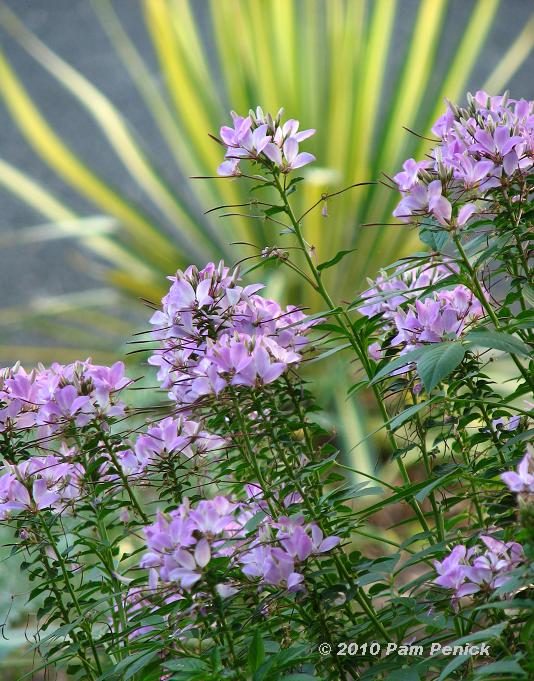
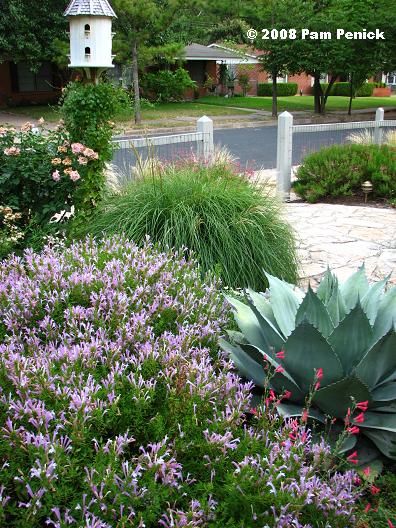
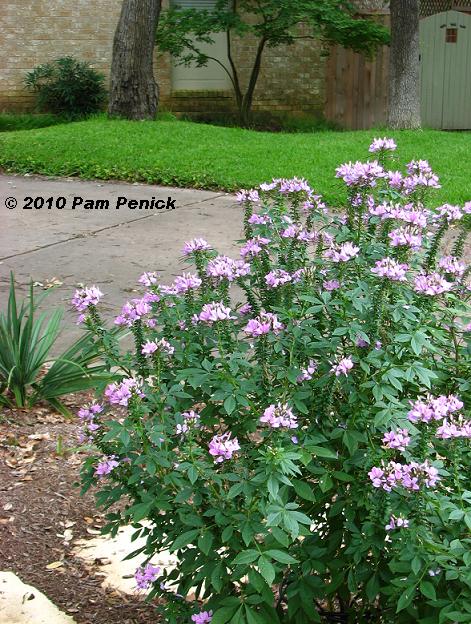
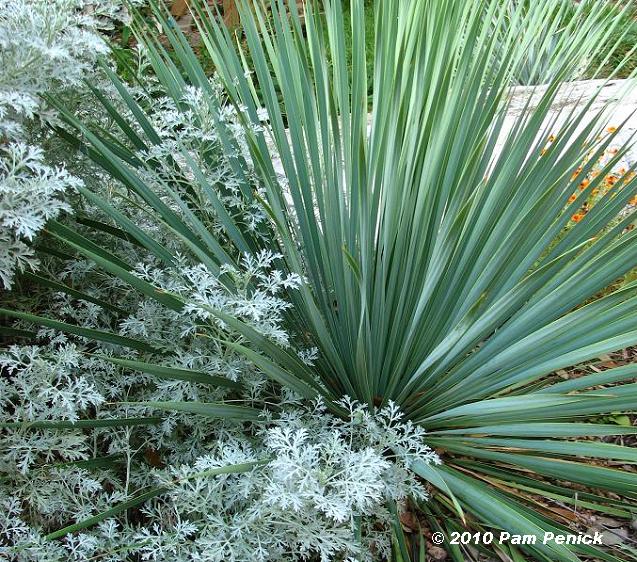
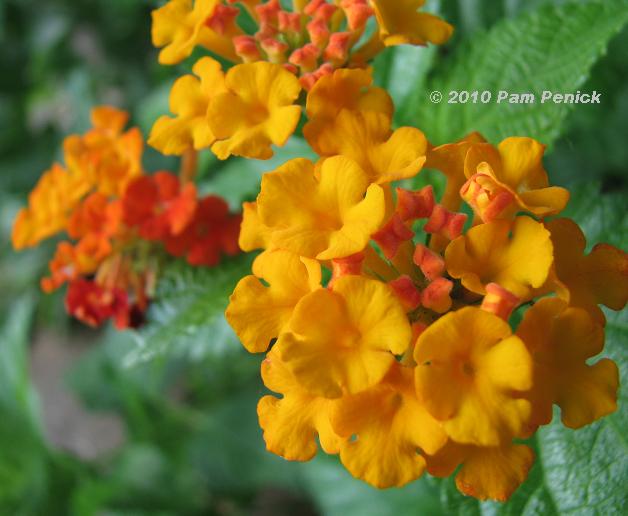
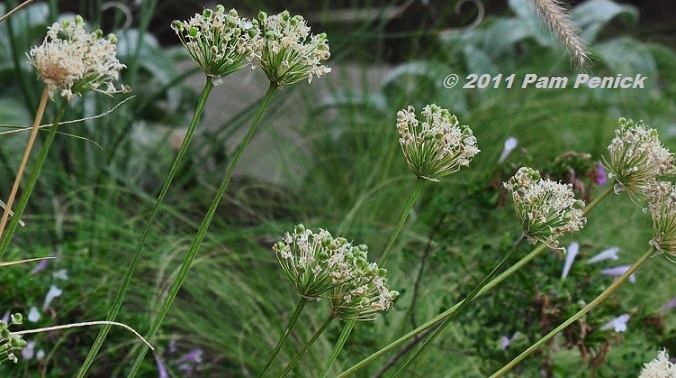
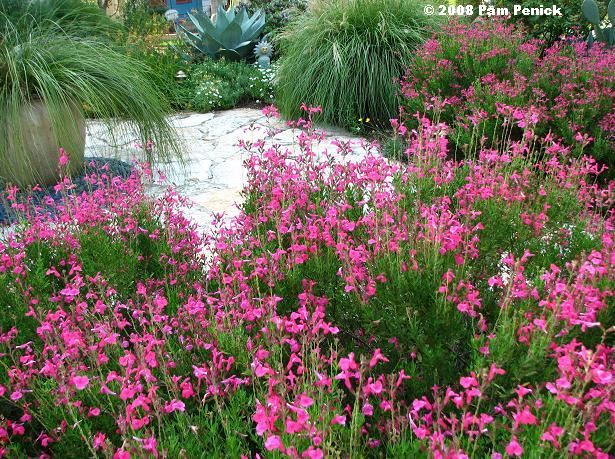
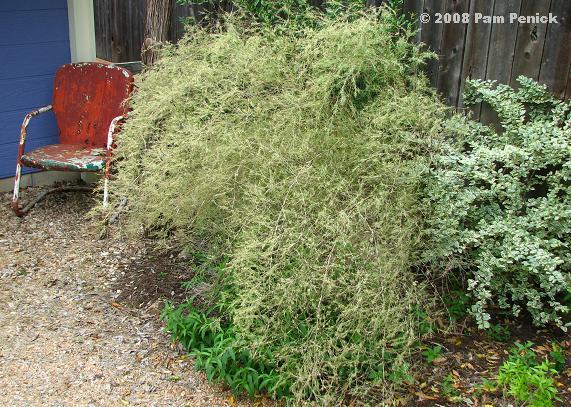
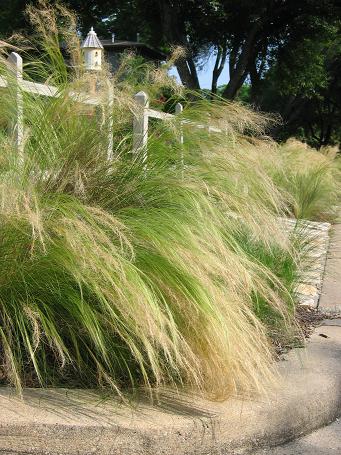
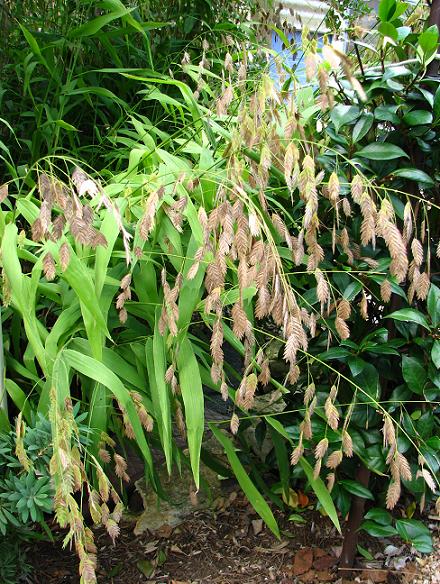
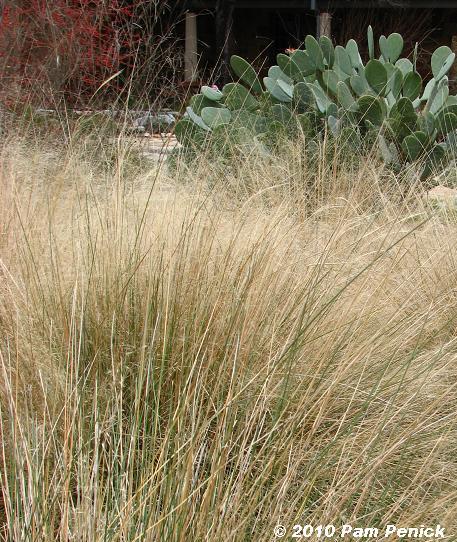
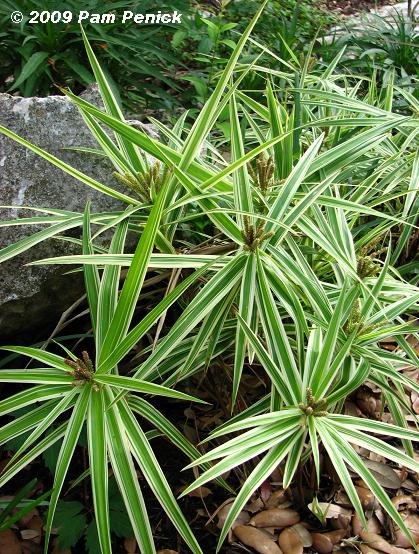
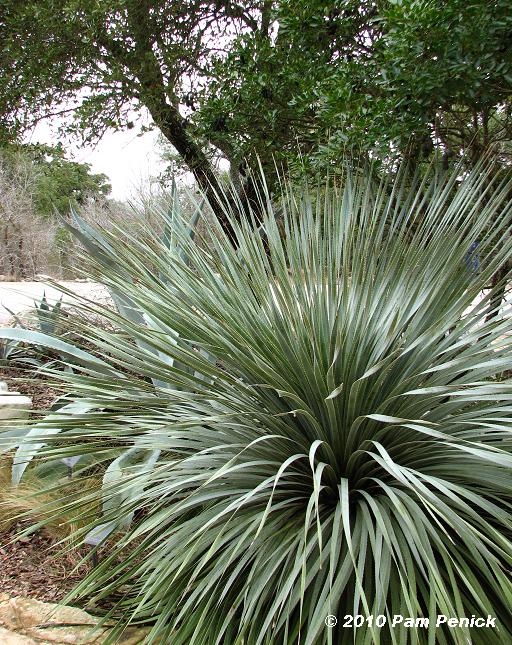
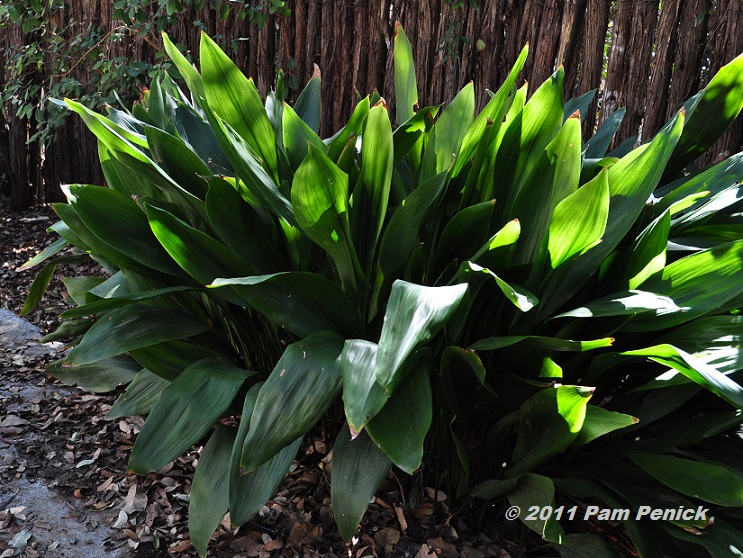
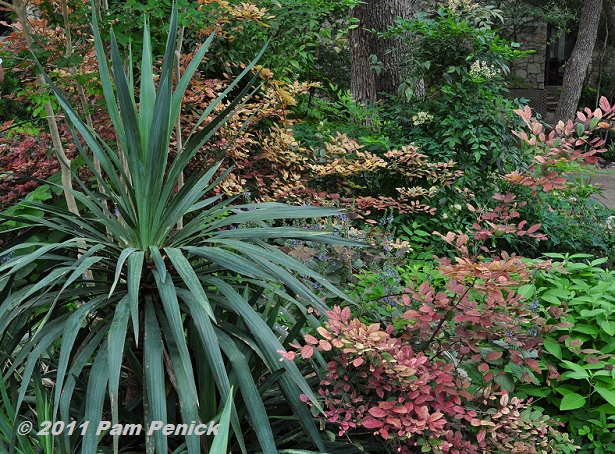
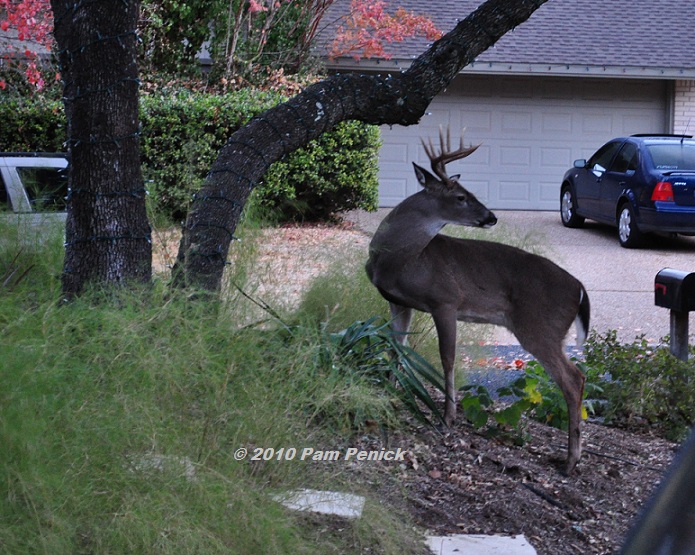
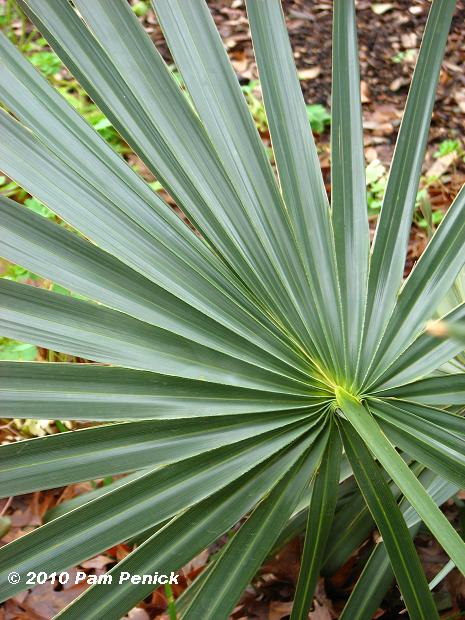
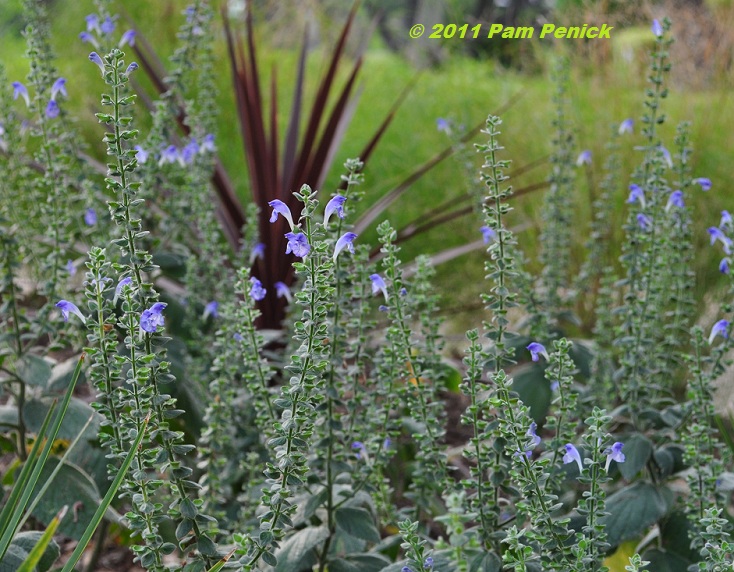
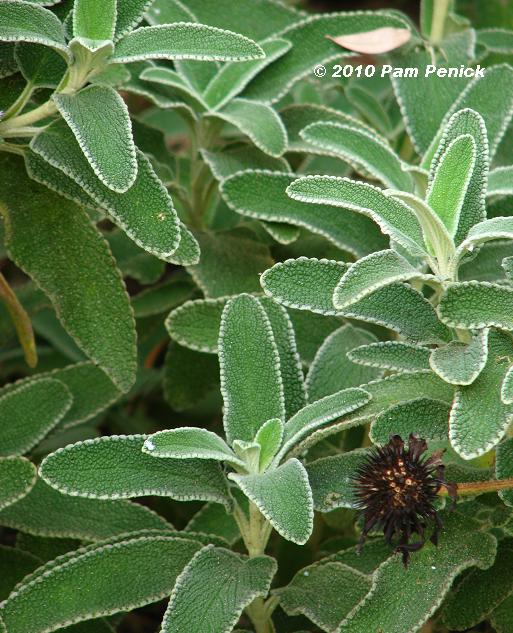
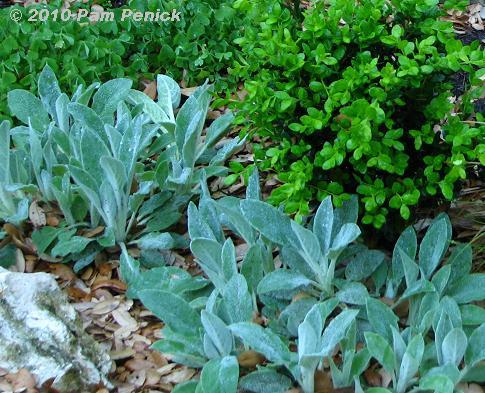
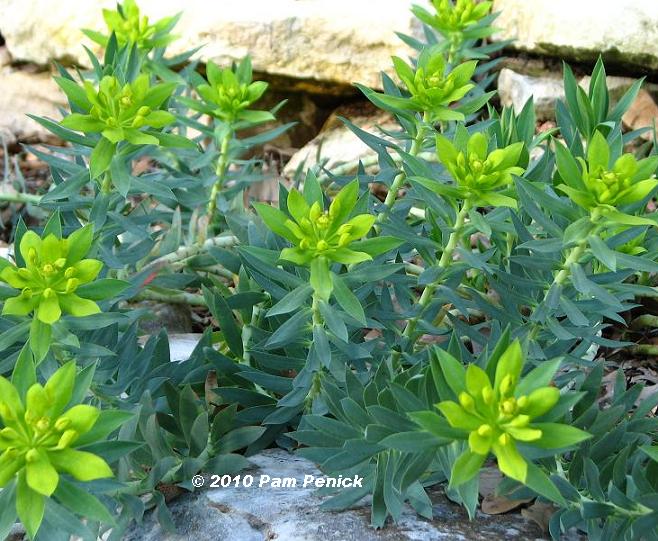
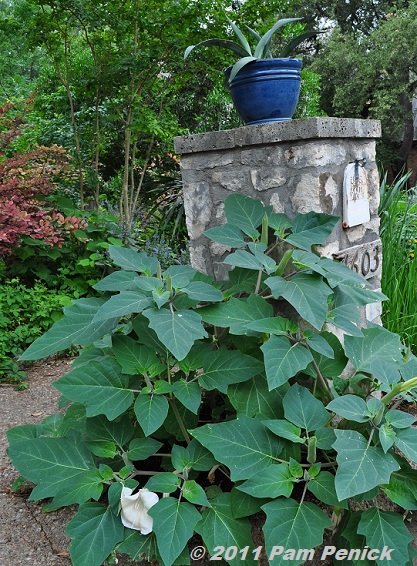
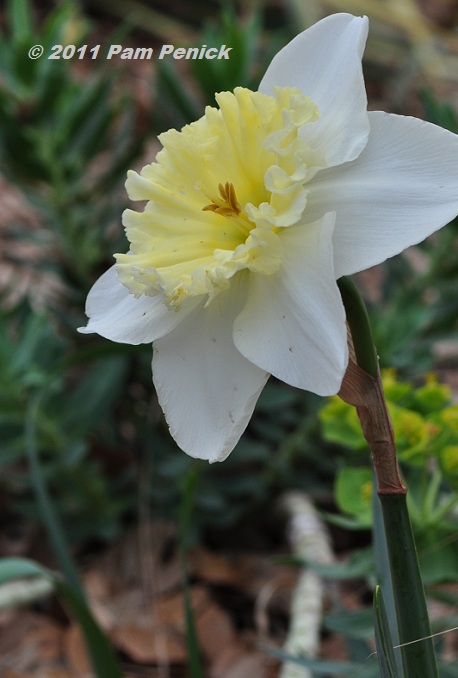
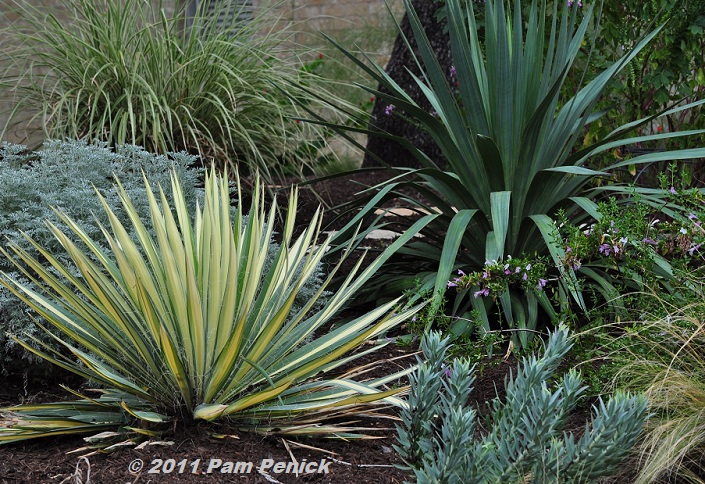
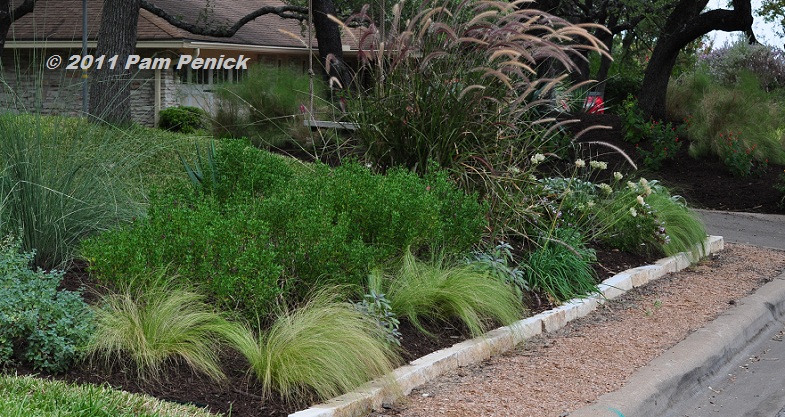
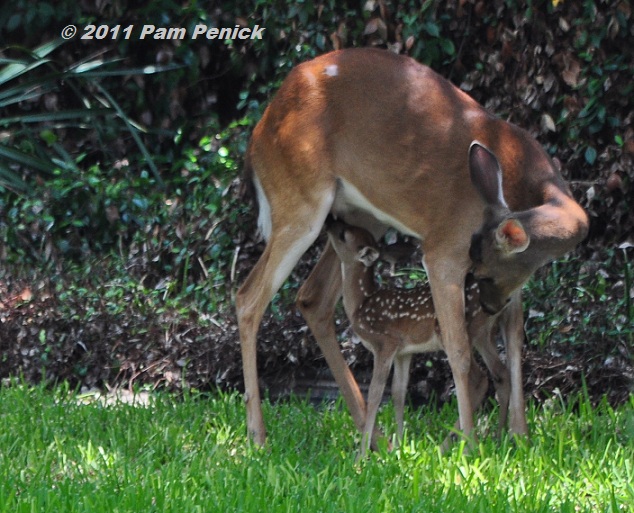
Pam, I love the picture of your beautiful lawnless front garden with the neighbor’s traditional grassy (boring) one in the background. What a great list of deer-resistant plants. I’ve never heard of Aspidistra elatior before, it looks remarkably like a plain green hosta. Are there cultivars with colored leaves?
Debbie, in recent years quite a few cultivars of Aspidistra have become available with yellow or white variegation; check out the link to Plant Delights’ catalog of cast-iron plant. I’ve only tried one of these newbies, and it did so-so in my former garden, never achieving the vigor of the plain green that you see all over shady central Austin. As for the lawnless front garden you admired, thanks! That’s the Texas-style cottage garden I left behind when I moved a few years ago. I still miss it sometimes! —Pam
I love your last line…in the neighbors yard. 🙂
Exactly. 😉 —Pam
Love your humorous attitude to this vexatious topic! U prove just how little u need be limited and how. Even in grey old UK we can grow quite a number of your recommendations. Of course diets vary, but it is always worth seeing wot other people find works.
Fab pics
Best
R
Thanks, Robert. It’s somehow comforting to think that England’s deer turn up their cute little noses at some of the same plants our Texas deer refuse. —Pam
Great list! You have some wonderful deer proof plants! I finally got a fence up in the back which keeps out the deer. In the front they occasionally wander by, but I am lucky in that they usually fill up at the neighbor’s garden first 😉
Thank goodness for fenced back gardens—and tasty plants at the neighbors’. —Pam
Pam, you have a good attitude about the deer. Very informative post. I have many of the smaller critters. Many of the suggestions you have work for rabbits also.
Thanks,
Jeanette
That’s good to know, for gardeners who have both, poor things. —Pam
Those are all great plants that deer seem to avoid even with our drought. Most of the natives work well. They’ve not sampled any of the salvias, including the softer stem ones.
My favorite this year has to be the Abutilon which has been ignored by the deer.
Shirley, I am pleased to hear that. I thought abutilon would be a deer favorite and have not tried it in the front garden for that reason. —Pam
Ahhhh….your photos have me drooling, Pam! And those deer – too darn cute (in someone else’s garden, right?) I haven’t had the best luck with loropetalum here, the deer seem to mow them down half the time. Looking forward to planting my skull-cap seeds that you sent me – especially since I now know they’re deer resistant!
I hope heartleaf skullcap will prove California-deer resistant for you, Rebecca. Too bad about the loropetalum. —Pam
Thank god I don’t have to deal with deer in my garden…but what a great plant list for those that do! (and I love that you worked in that line about eating venison…)
Heh heh, I couldn’t resist, Loree. 🙂 —Pam
Great list, Pam! There’s some beauties on there that I’m not familiar with and am going to look up. Fingers crossed they work in my Zone 9 gardens.
If they’re some of the seedy ones, Susan, let me know. I’m happy to share. —Pam
Wonderful list Pam and the photos are a treat on this gray and rainy day. gail
I’m glad you enjoyed them, Gail. It’s gray and rainy here today too, but we’re still delighted for rain. —Pam
They are so beautiful and so destructive. Fuzzy, hairy, aromatic all work here although the palette is just a bit different. I am basking in the photos as everything is dormant here in New England.
Some of these are dormant here too, Layanee. I picked a mix from various seasons. Hope you’re staying warm by a crackling fire. —Pam
We’ve battled more than our fair share of cervids on the farm. We fence the orchard and vegetable gardens, but are gradually coming to a consensus with the deer as to what they won’t eat. I do find that many of the deer resistant plants, including some of the sages, still need to be caged their first year to protect the tender young plants. We had some ‘Powis Castle’ Artemisia mowed down by curious fawns this summer, but now it’s bigger they leave it alone. Getting some plants through their first year can be challenging, but once the stems become woody, the deer here tend to ignore them.
You are so right—even deer resistant plants may get eaten up when they’re freshly planted, young and tender and surrounded by good-smelling compost and mulch. I always spray repellant on my new plants, just until they get established. —Pam
I am fortunate enough not to have to deal with the bambi invaders, but I love the plant list anyway. It’s nice to see what these plants look like when they are thriving. Alas, many of them do not look as good in my garden. Hopefully, one day I will learn the secret to your success.
Could the secret be selective editing of my photos, in order to show you plants at their peak? 😉 The only other secret I know of is proper placement; if you have something that’s not thriving, try moving it to a new spot (more sun, less sun, moister or drier soil) and see if that helps. —Pam
Great article. I shared it on Facebook. I hope that was okay. People are always asking what to do about deer, and you give them loads of options. We have a lot of deer out here where I live, but also lots of predators still including man.~~Dee
I’m delighted that you found my post worthy of sharing, Dee! You must have your deer situation figured out since you successfully grow so many roses (deer candy). —Pam
Venison still sounds yummy – medium rare! Thanks for all the options, though the deer have avoided my cul-de-sac for 13 years so far. Great stuff…
Lucky you, David, although perhaps your lovely purple wall would deter them anyway. —Pam
Pam, loved seeing so many great planting combinations! I knew about the “fragrant” approach, but had not considered the “fuzzy”. Will have to start a new list of options. Thanks!
Good old fuzzy leaves, and they’re so pleasant for us humans! —Pam
You really do have some wonderful plant combinations for deer proof plantings. I think I need to revisit my plantings and include some of these even where deer don’t come. I could also do with some improvements out by the street. However, there is no water there. Are you watering the ones you have in the front?
Yes, I do water, Jenny, especially as much of my garden is still so new, we’re in a drought, and I have so many competing tree roots. —Pam
Thanks for the informative article Pam – I look forward to trying some new plants! I too have a deer problem, especially after my fall planting of all “deer resistant” plants. I think many people forget that no matter what the plant, many tender nursery grown plants will be sampled in deer-prone areas. Fortunately a few exceptional perennials in my garden have never been touched- Blackfoot Daisy, Damianita, Wright’s Skullcap, Zexmenia, Skeleton-leaf Goldeneye, Mealy Blue Sage, and Cedar Sage.
I like all of your choices too, Ryan. You are right that deer love those brand-new, fresh-from-the-nursery plants. I often spray all my new plants with deer repellant for a couple of weeks in order to give them time to get established before experimental gnawing occurs. —Pam
Love the Artemesia/Yucca combo!
An interesting point to remember is that although deer don’t EAT daffodils they will still WALK OVER them trampling the emerging new shoots. I’m trying scrunched chicken wire over mine as a deterrent.
If it’s not one thing, it’s another where deer are concerned! Good tip about the chicken wire, Karen. —Pam
Hi Pam
What a green vinter you have and a lot of flowers. Here in Sweden we dont have any snow yet. Its only dark and gloomy and our garden is full of water from a lot of raining.
Regards Ken
Hi, Ken. We do have a very green winter in Central Texas. But these photos are recycled from other posts from various times of the year. December is not a flowery time of year in Austin, although we have plenty of greenery to enjoy. For flowers, April, May, October, and November are our best blooming months. Sorry to hear about your gloom in Sweden. Take heart—the solstice is near and soon the days will be lengthening again! —Pam
We have a herd of about 30 deer in just my neighborhood thanks to my two deer feeding next door neighbors. If it will grow in my yard it’s been tested!
I’ve shared my list on my site if anyone would like it: http://www.HillCountryGardens.info
Great article and pix, Pam.
Challenging conditions! Thanks for sharing your info, Jane. —Pam
Pam, I can feel for people living with deer and gardens, but there are ways to deter them or at least live with them. The farm I write about often, raises deer and has many wild deer surrounding the nursery, but NOT damaging the nursery plants. Their methods (like growing corn to feed them around the nursery field perimeters, employing predator scent, or having dogs patrol for example) cannot be utilized by suburban homeowners though, but we do much landscaping in deer areas. It is all about what is planted (like you mentioned) and how plants are protected from deer in winter. Deer eat just about anything in a lean snow-covered winter (not a problem you have), so protection (like burlap wraps) of the plants becomes a high priority. There is not too many plants considered deer proof, deer resistant is more accurate in most cases.
Interesting to hear about the methods used to repel deer at the farm you visit. I’ve heard that good dogs work really well, but like you said, that’s a solution for a country garden. I hadn’t thought about deer getting hungrier in the winter and having to use burlap wraps, but they definitely are hungrier here lately because of our terrible drought. —Pam
You have a lovely garden Pam. It’s a shame that Bambi is around. Don’t have that problem here. Your Bambi sure looks good compared to the ones here that have ticks & such making their fur very bumpy looking.
I suppose tick-borne diseases could be an issue here, but I never hear about it if so. It’s a contrast with the Northeast, which I understand has a terrible problem with Lyme disease from deer ticks. I guess we’re lucky in that regard. —Pam
I know deer are a bigger problem with you than us, Pam, and I really loved your post. Your photos are as wonderful as ever. Are you also a professional photographer? L
What a flattering question, Lesley. 🙂 It’s just a hobby for me, though I have sold a few images here and there. I’d love to have more time for it, actually. —Pam
Hi Pam, I love your blog- was introduced by Heather at xericstyle who is mentoring me (she tells me you’re her primary mentor, even if you didn’t know it at the time!!). I’m wondering specifically about red cordyline– I’m confused about whether it’s an annual or perennial in south texas. I’ve seen conflicting reports. Any advice? Thanks!
Hi, Salma. Red cordyline doesn’t like freezing weather, so I think of it as an annual here in central Texas, although it may survive in a warm winter in a protected location. In south Texas you’re a bit warmer, so perhaps it’ll survive most winters. No guarantees though. Happy digging! —Pam